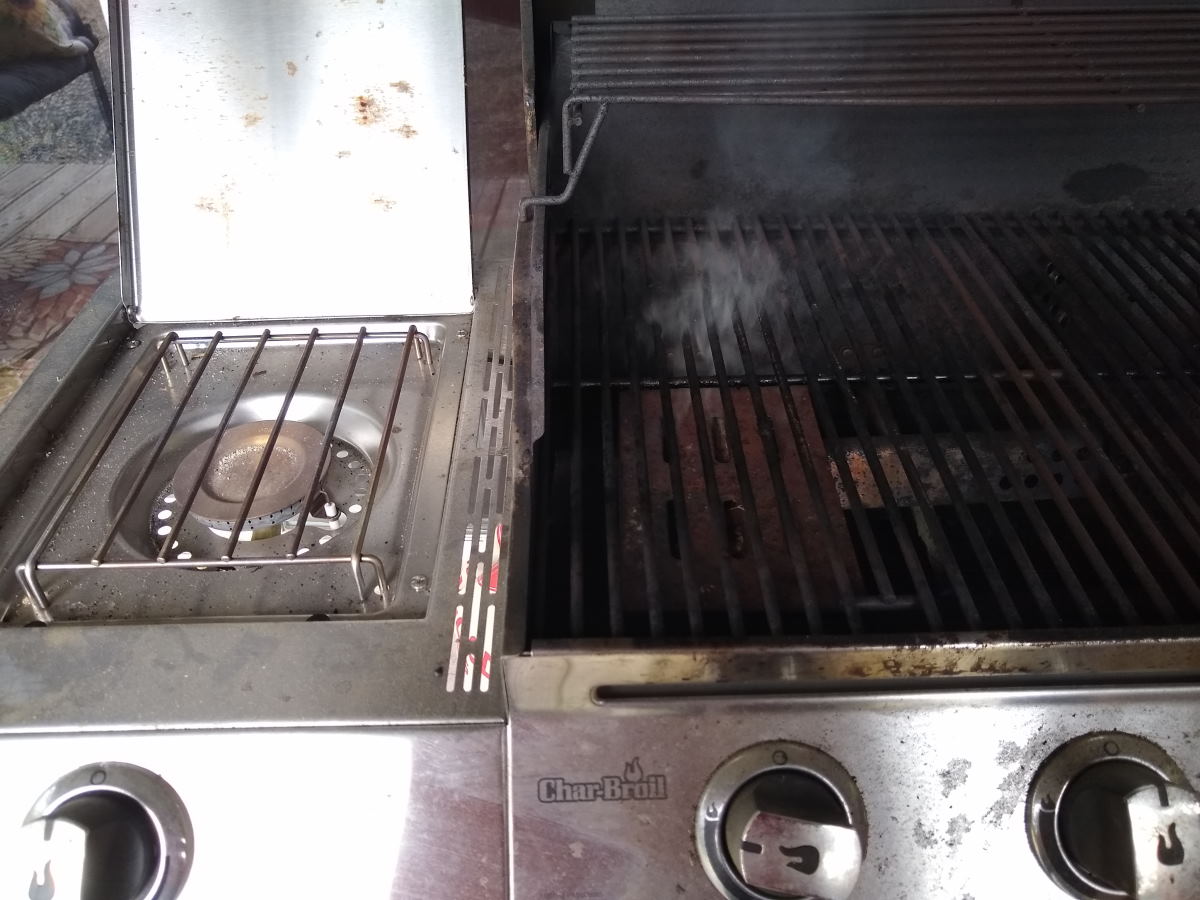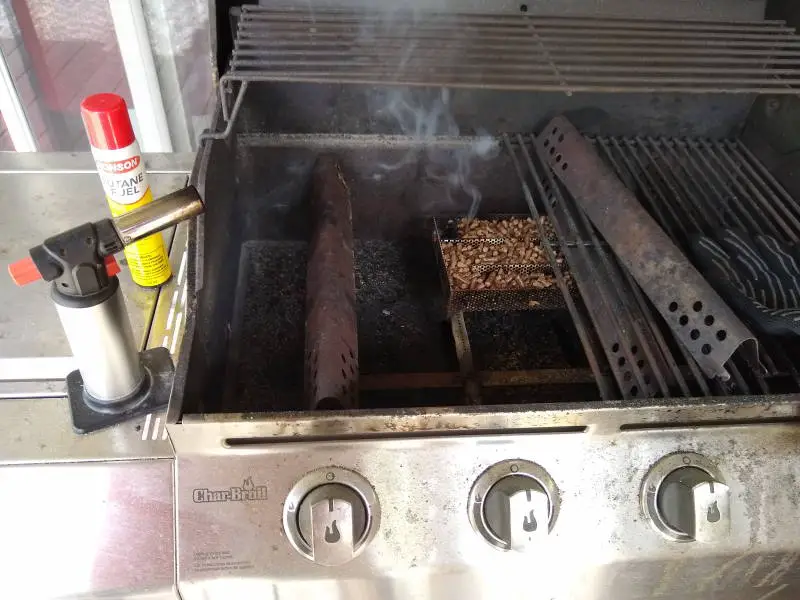
Gas grills are great — they’re convenient, easy to clean, and will cook just about any type of food, from vegetable kebabs to big chunks of meat. Sometimes, though, you miss that charred, smoky flavor only a traditional charcoal grill can provide. If you don’t have the budget for a new grill, you might be wondering how you can get your gas-grilled foods to taste more like charcoal.
To make a gas grill taste like charcoal, use a smoke box to infuse your food with flavor, add extra seasonings, use liquid smoke, and season your grill. Adjust your technique by using indirect heat, then searing, and remember keeping the grill closed will give you a richer taste.
Read on to learn what makes charcoal-grilled foods taste so unique and six methods to achieve the same flavor on your natural gas or propane grill.
Note: most links in this article are Amazon.com Affiliate links, see Affiliate Disclosure, thank you.
Why Does Charcoal Cooked Meat Taste So Good?
This might come as a surprise, but most of the difference you taste between gas and charcoal-grilled meats isn’t the flavor of the charcoal: it has to do with how charcoal cooks the meat compared to gas grills.
Contrary to what you may have heard, charcoal should not create much smoke. Instead, the smoky aromas come from meat and marinade drippings that hit the coals and turn into smoke and steam. The chemicals created by the drippings exposed to the hot coals cling to the meat and infusing it with intense smokey flavor.
Gas grills do the same thing when drippings hit the metal flame covers or vaporizer plates, but it’s not as efficient. This flavor isn’t nearly as strong as the compounds that the hot coals create on the surface of the meat.
What about the char? Charcoal grills can cook at a much higher temperature — some can reach over 700°F (371.11°C), while gas grills typically max out around 500°F (260°C). High heat puts a great sear on your steak, crisps up your chicken, and locks in flavor.
Note: A significant downside of this high-heat char is that it creates two chemicals called HCA and PAH, which The U.S. Department of Health and Human Services has said may cause cancer in humans.
How To Get a Charcoal Flavor on a Gas Grill
The flavor charcoal produces is different from a gas grill, but many people will opt for a gas grill because they tend to be cleaner and heat up much faster than charcoal. However, if you have the time to let your coals heat, you will notice a significant difference in your BBQ.
If you already own a gas grill, here are five methods to help you achieve more flavorful meats with propane and natural gas:
Burn Charcoal in your Gas Grill
Use these five easy steps to get a smoke flavor on a gas grill.
- Turn half or all of your gas burners off in your grill
- remove the flame deflectors
- place a small heavy-duty cookie sheet directly on the burners
- put a charcoal grate on top of the cookie sheet
- add a thin layer of well-lit charcoals
These steps are possible our favorite way how to get a charcoal flavor on a gas grill. You will get all of the flavor benefits of charcoal without buying a separate grill, and cleanup is simple by waiting 24 hours and discarding the charcoal ashes.
Also, you can use a small sheet pan and place it directly in the center of the grill to leave the flame deflectors on the outside burners allowing you to run them on low. This will enable you to get all the flavor of charcoal and a stable temperature from the gas grill burners.
On the downside, you will have your food close to the heat source because of the spacing between burners and grill grate surface. If you don’t have an upper grate, this could be a perfect time to add a raised grill rack to your gas grill.

Get a Smoker Box
Our favorite way how to get a smoke flavor on a gas grill is a wood chip or sawdust smoker box. A smoker box is a small, hinged metal box that you fill with wood chips, like this Pure Grill BBQ Smoker Box. Smoker boxes come in stainless steel and cast iron, but you can even get the same effect with wood chips wrapped in foil.
Fill your smoker box with your preferred wood chips — they come in a variety of flavors, such as this Western BBQ Smoking Wood Chips Variety Pack in hickory, apple, mesquite, and cherry — and place under the grate on deflector bars or over a burner.
Smoker boxes are nice because they don’t take up any grilling space. You can choose to soak your wood chips or leave them dry (wet chips create more steam but may prevent you from crisping up anything you’re cooking). Turn on the burner underneath the smoker box, and it should take less than a minute to start smoldering. Whenever you stop seeing smoke, you’ll need to reload the smoker box.
Use your gas grill with a smoker box like a slow smoker, or grill your food like usual. The longer time your meats stay in that grill with the smoker box, the deeper the smoky flavor.
If you prefer the longer burn time of wood pellets (or you already use wood pellets in a smoker), you can also find smoker tubes that you can fill with wood pellets. A Pellet Smoker Tube is an easy-to-use device that sits on top of the grate and gives the same effect as a smoker box. Light the wood pellets using a torch, give it a few minutes in the grill, and you’re ready to cook up some delicious and smoky meats or veg.
Turn Up the Heat
The biggest difference between charcoal and gas grills is the temperature at which they cook your meat. To have your gas grill mimic the cooking style of coals and try to get it as close to that charcoal sear as possible, you’ll need to up your temperature.
Replicate this on your gas grill by cranking up one side and leaving the flames off on the other. Sear your meats over high heat and move them over to finish on the unlit side. The sear and indirect heat combination should give you a nice browned outside like meat cooked over charcoal, but keep the inside moist.
Keep the Grill Closed
To build up and maintain the heat on your gas grill and get the intense heat of a charcoal grill, make sure the grill has adequate time to heat up and keep the grill lid closed. Cover the grates with foil or a sheet pan to get them extra hot, and avoid opening the cover while your food is cooking. The idea is to keep as much heat inside as possible, so no peeking.
Use Liquid Smoke
Liquid smoke, as the name suggests, is condensed “liquid” smoke taken from burning wood. It is made by burning wood — all different kinds, which is how you get flavored varieties — and collecting the vapors. The vapors turn to condensation, which is then distilled and filtered.
It is available in spray bottles or in glass bottles that look very similar to BBQ sauce. As it is condensed, a little goes a long way. Try adding 1/4 teaspoon to your marinade or BBQ sauce and brush over your meat.
If you find it too much, try diluting the same amount in water or vinegar. It is quite strong, so start with a small amount and adjust the flavor from there. Try this Wright’s Liquid Smoke variety pack that comes with mesquite, hickory, and applewood options.
Get Spicy With Rubs and Marinades
Don’t discount the flavor that a good marinade or rub can impart on your meats. Try marinating your meats in something like this McCormick Grill Mates Smoky Applewood Marinade(12 pack) before you throw that chunk of meat on the grill. Rubs like Spiceology’s Smoky Honey Habanero can also enhance the flavors of meat on a gas grill.
Using marinades and rubs is a safer way to impart flavor to your foods without the carcinogenic char of high heat. They’re also a great way to give a meaty taste to veggies, tofu, and other meat substitutes.
Read our article How to Get a Smoky Flavor Without a Smoker

Season your Gas Grill
The most overlooked way to add flavor to your gas grill is smoke seasoning. Using a pellet smoke tray or a metal smoker box is our favorite way to season a gas grill and give a smoky flavor to everything you cook. If you purchase an A-MAZE-N pellet smoke tray, it comes preloaded with pellets to perform one complete burn.
To season your gas grill,
- Remove the grates and set them aside.
- Light your pellet smoke tray with a camping lighter or a kitchen torch.
- Place the pellet smoke tray as low in your gas grill as possible and close to the oil drain to provide airflow.
- Close the lid and insert a long piece of foil in the air vent that is located in the back of most gas grills.
- Allow to smoke until the tray is totally done burning, around eight hours or more.
As the pellet tray burns, smoke should seep out of the edges and rotisserie holes of the lid. When you are done, remove the tray, clean any ashes that have landed in the bottom of your grill, and reinstall the cooking grates.
Another option is to make a charcoal snake on a charcoal grill grate or a cast-iron pan and burn that low and slow. Adding a few wood chips or chunks can add flavor but don’t add too much wood because it can flare up and leave a burnt taste in your gas grill.
Final Thoughts
Many people loved the smoky flavor of a charcoal grill, and luckily, there are many ways to achieve this from your gas grill. Let’s recap the methods to find which might be best for you:
- Use wood chips. Wood chips and pellets can add a smoky flavor to gas grilled foods. Use a smoker box, pellet tube, pellet tray, or wrap wood chips in foil.
- Keep the grill hot. Make sure you give your grill time to heat and don’t open the cover too often.
- Add some spice. Give your food a smoky aroma and flavor with liquid smoke, marinades, and rubs.
